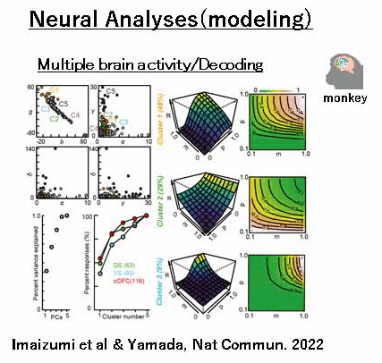Progress Report
Maximizing well-being and agency on the basis of interpersonal comparison of brain indicators[4] Comprehensive understanding of utility representation in primate brain for interindividual comparison
Progress until FY2024
1. Outline of the project
We have obtained evidence to understand how pleasure and aspiration evolved and drove us to achieve goals in the brain. Particularly, both monkeys and humans feel similarly during the gamble; after lucky win they feel more likely to win. Our findings were reported at the high-ranked scientific journal (Project 4-1). We have developed behavioral tasks to examine the subjective value of reward and hierarchical cognition in macaque monkeys, and obtained preliminary results suggesting functional differences in the prefrontal cortex, amygdala, and hippocampus. We also conducted fMRI experiments in humans to examine interactions between hierarchical cognition and social preferences and found that prosocials and proselfs use their brains differently (Project 4-2).
2. Outcome so far
- (1) Research and development in identifying neural representations of utility
- We estimated the parameters that individual neurons in brain regions involved in reward processing have when representing expected subjective value and selected the best model. The results were published in an international journal (Imaizumi Y, et al. and Yamada H. Nat Commun. 2022, 13(1): 5855).
- (2) Research and development aimed for monkey-human interspecies comparison of utility estimated from behavior
- By conducting similar behavior measurement experiments in monkeys and humans, we directly compared their gambling behavior and showed that their value judgments are very similar. (Dynamic prospect theory: Two core decision theories coexist in the gambling behavior of monkeys and humans. Tymula A et al, and Yamada H. Sci Adv. 2023, 9(20): eade7972.) (Project 4-1).
- (3) Hunger and thirst are evaluated by blood contents (Suwa et al & Yamada, 2024). A new analytic tool for brain activity was developed and applied to brain-wide activity (Chen et al & Yamada, 2024, 2025)
- (4) Research and development to elucidate neural indices of subjective value of reward
- We trained monkeys on a newly-developed free and forced reward choice task, recorded neural activity in multiple brain regions, and obtained results suggesting functional differences between the OFC and amygdala.
- (5) Research and development to elucidate neural indices of hierarchical representation of aspiration
- We have also developed a category reversal inference task requiring hierarchical processing and identified reward predictive and category-encoding neurons in the macaque LPFC and hippocampus. In addition, to examine the interaction between hierarchical cognition and social preferences, we developed a donation task and conducted fMRI experiments. We found that the prosocials and proselfs showed contrasting behavioral tendencies and neural representations. This study received an excellent poster award (23rd Winter Workshop of "Brain and Mind Mechanisms"). (Project 4-2)

3. Future plans
We established the biologically plausible model for the inter-individual comparisons by developing an identification technic for collective activity analysis of multiple brain regions involved in the neural representation of utility. Now, we aim to measure blood ghrelin concentration, which is an indicator of hunger, in order to establish an objective evaluation method for craving. Then, we will identify the biological principles that yield human pleasure and aspiration (project 4-1).
To reveal the brain mechanisms that represent the subjective value of rewards, we will conduct functional network analysis of multiple cortical and subcortical areas to the data obtained from free and forced reward choice tasks. We will further explore the hierarchical dynamics in the brain using the devaluation method and pathway-selective chemogenetic manipulation. This study intended to mediate the translation of findings from inter-individual comparisons of neural representations of reward value in rodents to human understanding. (Project 4-2)
(YAMADA Hiroshi: Tsukuba University,
OGUCHI Mineki, Tamagawa University)